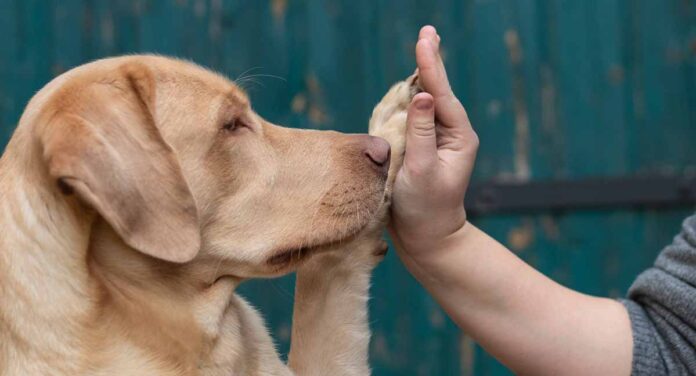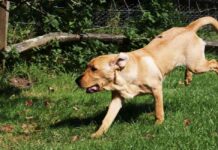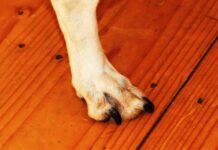Games aren’t just a great way of entertaining bored dogs. They exercise their bodies and brains, and even teaching your kids to play safely with their big, bouncy friend. Today I’ll share the best games to play with your dog. These activities will build a more positive structure to the way you interact with each other, and give your pup some new skills too. Through what will feel just like fun and games for the pair of you, you’ll actually be laying for the foundation for obedience skills like sit, stay and even stop.
A great deal of modern dog training is done through games, and it is without a doubt the best way for your furry friend to learn.
Contents
The secret to successful play with a large dog is to define the boundaries and rules of the game, and to control where it starts and stops. This is almost impossible with free play or rough housing, where dogs often become over-excited and careless. Structured games enable you to remain in control whilst keeping your dog happy and entertained.
1. Scent Games To Play With Your Dog
Dogs have amazing noses. It is not just bloodhounds that are great at following a trail. Labradors can do it too. Try laying a scent trail for your dog, with a treat at the end, and watch him follow it with his nose. You’ll need to begin with very short and simple trails. And you’ll need a few simple bits of equipment
What You’ll Need
Your dog will need to be on a lead, and it is best if this is attached to a harness. You will lay your trail with a scent marker. A piece of cloth rubbed in some roast meat juices should do the trick. And you will also need some little chunks of roast chicken or beef steak, for the treat at the end of the trail.
Your First Scent Trail
Lay your first trail in a straight line on an open piece of ground. Keep your dog out of sight while you do this.
Step 1
Mark the start of the trail with a cone or a rock, so that you know where to begin tracking Drag your cloth along for 3 feet. Place a little piece of meat or some other yummy treat at the end.
Step 2
Now fetch your dog and take him to your start marker. Watch him sniff around and follow the scent to the treat.
Step 3
Repeat a few times. He’ll quickly get the idea of the game. Now you can start to make the game more fun.
Making scent work it more difficult
One way to make the game more challenging, is to make your trails longer. You can also gradually introduce turns or changes in direction so that the trail is wiggly rather than straight. After a few weeks of practicing you will be able to lay quite complicated trails for your dog to play the scent game. The next game can be played indoors
2. Statue Games To Play With Your Dog
In this game, your dog has to sit perfectly still without moving a muscle, whilst you walk all around him in a circle. Take care not to step on his tail as you cross behind him. You teach this game in easy stages, using an event marker to let the dog know when he is on the right track.
Your event marker
The event marker is just a sound that you make each time the dog is successful. It can be a word like ‘Good’ or ‘Yes’, or a click you make with your mouth or with a clicker. Don’t forget to reward the dog with a treat, each time you use your event marker.
Step 1
To begin with, sit your dog next to you, stand still, and watch him carefully. As soon as he is completely still, mark and reward!
Step 2
The next step is to mark and reward 3 seconds of not moving. Fidgety dogs may need you to mark 2 seconds first, and then move on to 3.
Step 3
When your dog can sit like a statue for 3 seconds, it is time to teach him to keep really still whilst you move your leg. To start with, just lift one foot off the ground and put it back down again. If he keeps still, mark and reward. If he moves or fidgets go back to standing still for 3 seconds, then try and smaller movement of your foot.
Making it more difficult
Once he can do this, you can progress to bigger movements of your leg. Don’t forget, he must not move a muscle. If he moves, make the game easier for a moment. When you give him his treat, let him move around, then bring him back to sit next to you for the next attempt.
Over the space of five to ten games of five minutes each, you will be able to progress from lifting your leg, to taking a step to one side, to taking a step backwards. All without the dog moving. Soon you will be able to step forwards, turn and face the dog! You will also be able to step back wards and to one side, so that you step across his tail. Mind you don’t tread on it.
It is then just a short step to be able to step all around your dog whilst his sits like a statue. Don’t forget, this game requires concentration, and most dogs like to have a good zoom about outside afterwards!
3. Search Games To Play With Your Dog
Dogs who are attached to their toys love this game.
Step 1
Choose a toy your dog really loves. Use the name of the toy a lot whilst your dog is holding and playing with it.
Step 2
Now sit your dog or get someone to hold him and let him see you take the toy through and open doorway and place it on the floor in full view in another room. Go back to your dog and tell him to find his ‘rope/ball/teddy’ in a happy, upbeat voice. Tell him how clever he is when he gets it.
Step 3
Repeat a few times, then begin to make things more complicated.
Making it more difficult
Try placing the toy where he cannot easily see it until he is in the room. Don’t hide it under anything yet. You need to build up his skill gradually. After a few more games, you will be able to make the game more difficult, hiding the toy under a cardboard box or a cushion. You can also teach your dog different names for different toys and see if he can pick up the right one.
4. Teach Your Dog To Freeze!
This is great fun to play with an active dog.
Step 1
Have your dog move around near to you. Keep throwing him tiny treats to hold his attention and dance around to keep him moving. Now suddenly stop and ‘freeze’. If he copies you and stops moving, ‘mark and reward’ then throw a treat behind him and away from you.
Step 2
Start dancing around again. Each time you freeze, wait for him to freeze too and immediately mark and reward.
Step 3
Now you can start to add a cue word. Dance around, say ‘freeze’ and stop dancing. Mark and reward the dog when he stops.
Making it more difficult
Now start throwing the treats further away and saying freeze when he has picked up the treat and is starting to return. To begin with he may carry on running towards you before he ‘freezes’. But as long as you always throw the treat well behind him, he will soon start to freeze further from you.
Freeze is not just a fun game, it can also be a useful cue to give a dog that is heading towards danger or getting too far away.
Keeping it fun
With all these games, it pays to make haste slowly, and to stop whilst the dog is having fun. Most dogs will enjoy playing ‘find the toy’ three times in a row. Many dogs will get bored if you carry on much longer than this. Stop after five or ten minutes, and he’ll be keen to play again next time.
Make Learning Fun
If you are just starting out, or switching to modern force-free methods, training can be challenging at first, so I’ve also put together some free training tips to help you. Just drop your name into the box below if you’d like to receive them.
The Labrador Site Founder
Pippa Mattinson is the best selling author of The Happy Puppy Handbook, the Labrador Handbook, Choosing The Perfect Puppy, and Total Recall.
She is also the founder of the Gundog Trust and the Dogsnet Online Training Program
Pippa's online training courses were launched in 2019 and you can find the latest course dates on the Dogsnet website


















I have found it necessary to discourage my Lab from picking up food from the floor. We had a couple of food games and while she enjoyed them I wonder if they promoted the prowl for food on the floor. Given that Labs are SO food motivated I gave up the games and began dropping bits of treat then telling her “Leave it”. It took a while but seems to be working. I give her treats only from my hand or “in your dish”. Holly is a Therapy Dog and it can be hazardous for her to scrounge round wheelchairs and walkers for muffin crumbs or whatever. We once spotted 3 pills on the floor at the same time, since she is closer to the floor she managed to get one in her mouth…I was lucky to get it out before she swallowed it!
Now I have back tracked my own theory re picking up food. Holly (is 6 yrs.0ld) has developed an aversion to going up strange stairs. I don’t believe it to be a physical reason… more about which paw to put first! After having someone carry her up the stairs, I decided to put a bit of meat at the top of the stairs at home (where there is never a problem) in the hope she comes to think about a treat at the top rather than how to get started going up! If we could only get inside the head sometimes!! Hopefully she learns a reward waits at the top and that is the only time she can take it from the floor!
Hi
There are lots of sites explaining how to train your dog ….but I want help with daily exercise.
I strongly suspect the pro dog men (and women) don’t ever take their dogs out for a walk; they are either in their kennels or out being trained or worked. I want to know how best to exercise my pup so that he has sufficient exercise and burns enough calories and has the chance to empty his bowels
I am getting the balance wrong . I am giving him too much free running and allowing him to hunt freely but I don’t know how to restrict his free hunting and at the same time allow him enough exercise
Unfortunately he isn’t a great retriever buts loves to hunt hunt hunt hunt ……he is constantly self rewarding…..I recognise the problem……but don’t know how to fix it short of shutting him up every time he isn’t being trained
Hi Eddie, drop into the forum where we can chat. Several experienced gundog trainers there too. 🙂 https://thelabradorforum.com
My black Lab, Moxie, is two years old….for the most part, she responds to my commands….sit, stay, come, wait…BUT, and that’s a very BIG BUT, we live in a rural setting, 30 acres, with deer and jack rabbit abounding.
When one of those run across in front of her she’s off and nothing will stop her or bring her back until the animal is so far ahead there’s no hope of her catching them. Fortunately, we live on a county road with very little traffic, but traffic isn’t the only concern.
Anyone have any suggestions short of keeping her on a lead?
Curing a dog with an established chasing habit can be a long job. You’ll need to retrain your recall, probably with a new cue, and use a long line to prevent your dog self rewarding until you have a reliable response. You’ll get lots of help in the forum https://thelabradorforum.com
My oldest son has taught our lab to box. She can’t get enough of it. He uses the same moves consistently and the dog has learned to dodge, roll and block his moves. It is hysterical to watch. She goes 20 or 30 minutes before ending the game. They do this almost every day because she pesters him till he gives in. Her mental strategic moves are impressive
I was surprised when I took a toy that my puppy was playing with and placed in another room out of sight. I entered the room and then told him to ‘find it’ and he zoomed off sniffing in the other room. I repeated ‘find it’ and he gets excited and ends up finding his toy. I give him lots of praise. He went from a simple place to a complex place within minutes.
I almost get the feeling that my puppy is an old soul and has been here before, I am just reminding him of what he seems to already know. So far, very proud of my 14 week old Labrador.
I have him doing the following:
-Sitting
-Laying Down
-Standing Up
-Fetching
-Bringing Back
-Waiting for his food while on the ground in front of him
-Waiting at the door and letting me leave first as well as enter when we return
-Finding toys or treats I have hidden
-Crawling
-Paw / Shake
-And believe it or not, showing me where I get water from and where I put it once I get it.
I am mind blown at how smart he is and this is my first dog, so I have no idea what I am doing. This site as been a major asset for me and giving my dog the best training that I can do myself.
Thank you!
Me and my Mollie love to play at hide and seek. As soon as we get to the beach or the park, I throw her ball for her, then she picks it up brings it back to me before running off and hiding! As she is a choccy, sometimes it’s hard to see her against the trees in the park and the groynes on the beach! She peeps out to see if I ‘m still there and we have a great time. A lot of people stop to watch us and laugh.
Ours is fFind the Treat!? I have the dogs leave the room. I hide small pieces of treats around the house….window sills, on top of anything I can find, in corners, under tables, etc…..when I am done I open the door, they have to sit and stay..then I tell them to find the treat. Their noses take them everywhere. First time they weren’t sure what to do and kept coming back to me because they could smell it on my hands. Now, their noses take them all over the rooms it’s hidden it. So mentally stimulating for them!
I’ll definitely try the bloodhound one!
Hide and seek I usually get a toy and get my lab excited with it then I throw it out the back door into the garden then I run and hide then when the dog comes i say his name and he goes to find me (he is actually really good at this due to him knowing my scent)
Hi My pup, Austin, is now 10 weeks old. He can do the basics of sit, walking with a lead and is house trained but he does not seem to go further than that with more instructions or games. What would be a good age to start teaching him more? Any ideas please?
I would say right now is a good time, other would probably suggest otherwise. I have been using treat training since I got my pup, which was 4 weeks ago and he has progressed really quickly. I think they need a little guidance at first and with the help of a treat and luring him into situations has seemed to work wonders for me.
I have a session of pure treat training where I do the basics: sit, down, come, etc…
Then I move on to a bit of fun and messing around. Get his excitement out of his system.
Then I calm him down by taking away any distractions and move back to a few minutes of training but this time I use the treat as a lure. I hold it in my hand so he can smell it but can’t see it and I have him do all sorts before he earns it. I don’t push it too far though. I don’t want him to lose interest. So, I usually do about 4-5 commands and then treat him and repeat. Seems to be working well for me and he enjoys it.
It’s never too early to start training in my opinion.
Oh yah and give it the treat 🙂
Hide and seek. the family of four started in a circle each with some treats. We stood very still, and in turns called ‘find Max!’ or whoever was to be the target. At first that person would call Miriam (who was very small then) and reward when she came. Later we would stay silent – she would sniff around each of us, and when she got to the right person – a big fuss and a reward. That person would nominate another and so on. Now, in the woods one of us will hide behind a tree whilst she isn’t expecting it. We then call her and give the command to find the missing person (sometimes several hide at once.) She charges around until she gets the right target. She will go to any of us at a command from another, but if that person isn’t there she tends to guess. Useful when its someone else’s turn to bath the dog.
Here’s another version of hide and go seek. First, you get a treat and show the dog. Next, you tell him/her to stay or whatever word you use for it to stay. And show the dog your treat again and go hide somewhere easy. Then yell okay! Or whatever word you want to use. Once you teach it good enough, it will come looking for you and eventually find you. Once it finds you, tell it good boy\girl! Your dog will highly enjoy this game
We live in Chicago where the weather can get very, very cold. An activity that I have found that works great to tire our labs out is to throw a ball down the stairs and have them bring the ball back up the stairs to you. The stairs is good exercise for them. And you can just relax while you are wearing them out. 🙂
I would be a bit wary about labs on the stairs. Their front leg joints are hugely complex and can be fragile with the impact of the weight of the dog pounding on them running down stairs. We don’t allow ours upstairs at all, just for this reason. It would be interesting to know if this is true, or just an urban myth.
I don’t really have a choice with my dog. I visit my parents often and they live in an upstairs flat. So much dog has to go up and down stairs multiple times while we are there. I wouldn’t be using it as a means to wear him out though. I just feel its important for them to understand how to use stairs. My dog stays down stairs at my house but I do treat him to a short investigation upstairs from time to time and he loves it.
I would also like to hear others thoughts on this and if it is damaging or not?
We recently moved into a house that has a second floor and basement. Our lab Penny goes up the stairs to the second floor with ease (sometimes she runs up) but we have to tell her “slow” and “easy” coming down as she tries to hurry and has slipped on a few steps (although she didn’t hurt herself). She does not venture down the basement stairs – not sure if it’s because the walls are close and not open or what. She’s made it down 3 steps but no more, not even with treats. Not sure what we’ll do when there’s a bad storm and we have to go downstairs.